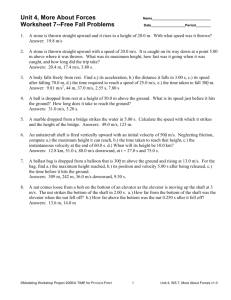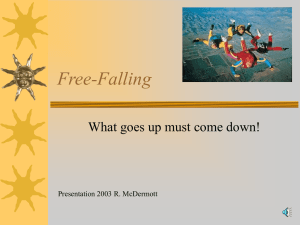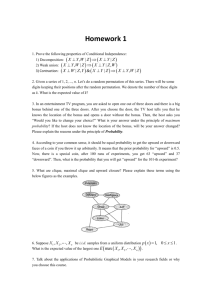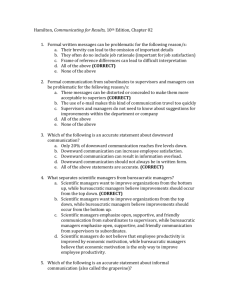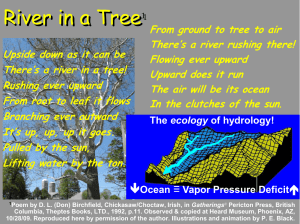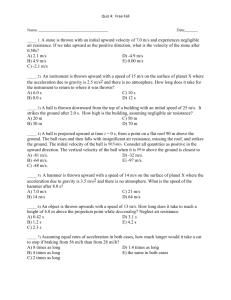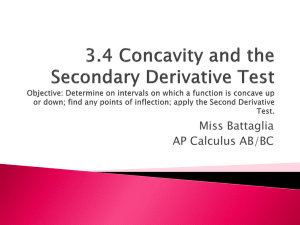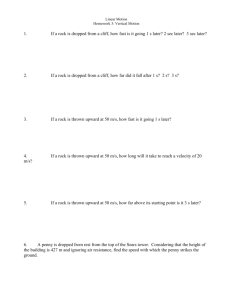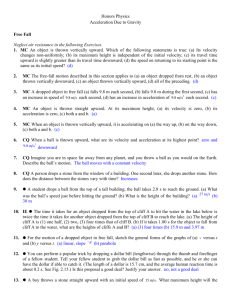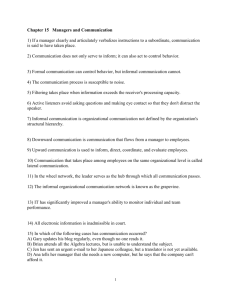Freefall Worksheet
advertisement
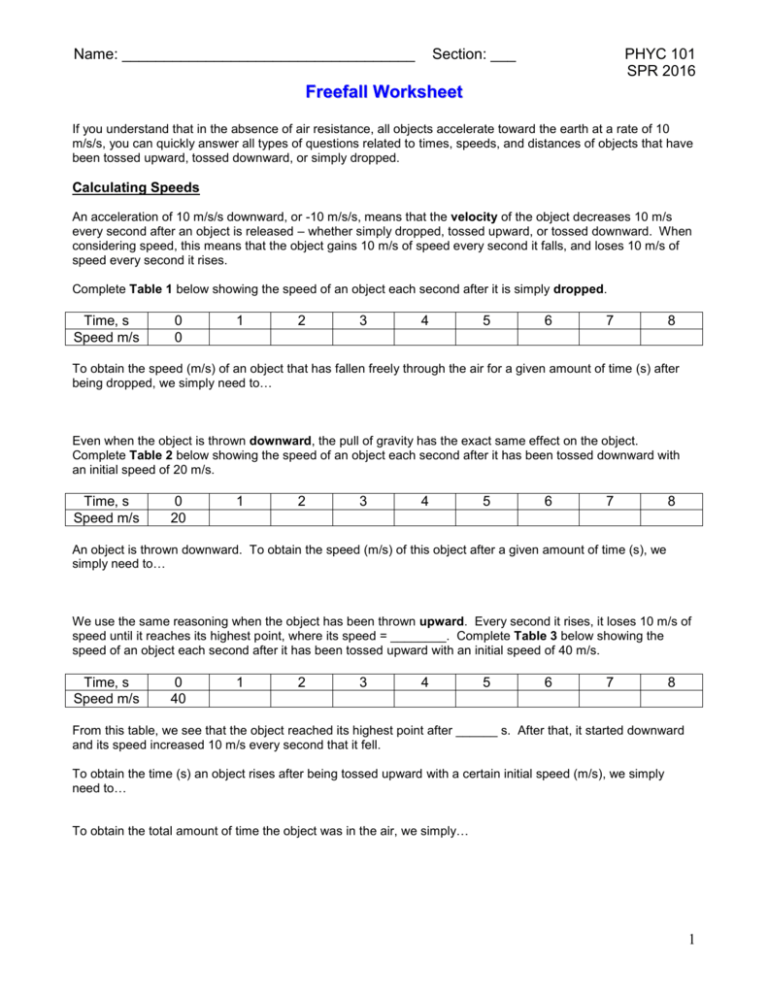
Name: ___________________________________ Section: ___ PHYC 101 SPR 2016 Freefall Worksheet If you understand that in the absence of air resistance, all objects accelerate toward the earth at a rate of 10 m/s/s, you can quickly answer all types of questions related to times, speeds, and distances of objects that have been tossed upward, tossed downward, or simply dropped. Calculating Speeds An acceleration of 10 m/s/s downward, or -10 m/s/s, means that the velocity of the object decreases 10 m/s every second after an object is released – whether simply dropped, tossed upward, or tossed downward. When considering speed, this means that the object gains 10 m/s of speed every second it falls, and loses 10 m/s of speed every second it rises. Complete Table 1 below showing the speed of an object each second after it is simply dropped. Time, s Speed m/s 0 0 1 2 3 4 5 6 7 8 To obtain the speed (m/s) of an object that has fallen freely through the air for a given amount of time (s) after being dropped, we simply need to… Even when the object is thrown downward, the pull of gravity has the exact same effect on the object. Complete Table 2 below showing the speed of an object each second after it has been tossed downward with an initial speed of 20 m/s. Time, s Speed m/s 0 20 1 2 3 4 5 6 7 8 An object is thrown downward. To obtain the speed (m/s) of this object after a given amount of time (s), we simply need to… We use the same reasoning when the object has been thrown upward. Every second it rises, it loses 10 m/s of speed until it reaches its highest point, where its speed = ________. Complete Table 3 below showing the speed of an object each second after it has been tossed upward with an initial speed of 40 m/s. Time, s Speed m/s 0 40 1 2 3 4 5 6 7 8 From this table, we see that the object reached its highest point after ______ s. After that, it started downward and its speed increased 10 m/s every second that it fell. To obtain the time (s) an object rises after being tossed upward with a certain initial speed (m/s), we simply need to… To obtain the total amount of time the object was in the air, we simply… 1 Name: ___________________________________ Section: ___ PHYC 101 SPR 2016 Calculating Distances The easiest way to calculate the distance an object in freefall travels – whether it is the height it rises or the distance it falls – is to make use of the relationship that the total distance is the product of its average speed and time (d = vt). For constantly accelerating objects, the average speed can be found by dividing the sum of its initial and final speeds by two (vav = ½ (vi + vf)). If we want to know how far an object falls during some specified time after release, we need to multiply that specified time by the object’s average speed during that time. For example, the distance an object falls in 3 seconds after release will be 3 s multiplied by its average speed for those 3 s. Since the initial speed was 0 and the speed after 3 s is 30 m/s (see Table 1), the average speed for 3 s of falling is 15 m/s. If something falls 3 s with an average speed of 15 m/s, it will travel a distance of 45 m. Complete Table 4 below showing the distances an object falls during 1, 2, 3, …, 8 s. Time, s Speed, m/s Av Speed, m/s Distance, m 0 0 0 0 1 2 3 30 15 45 4 5 6 7 8 Remember that Galileo discovered that an object will fall four times as far in twice the time. This means that the distance an object falls in 2 s should be 4 times as far as it falls in 1 s, and the distance the object falls in 8 s should be 4 times as far as it falls in 4 s, etc… He also found that an object will fall 9 times as far in triple the time. This means that the distance an object falls in 3 s should be 9 times as far as it falls in 1 s, and the distance the object falls in 6 s should be 9 times as far as it falls in 2 s, etc… Does your table of values confirm Galileo’s discovery? _______ We can use the same line of reasoning to determine how far an object falls after being thrown downward. Complete Table 5 below showing the distances an object falls during 1, 2, 3, …, 8 s after being thrown downward with an initial speed of 20 m/s. Time, s Speed, m/s Av Speed, m/s Distance, m 0 20 0 0 1 2 3 4 5 6 7 8 This same line of reasoning can be used to determine how high an object rises above its release position after being thrown upward. Complete Table 6 below showing the height an object is above its release position 1, 2, 3, and 4 s after being thrown upward with an initial speed of 40 m/s. Time, s Speed, m/s Av Speed, m/s Distance, m 0 40 0 0 1 2 3 4 It then falls back down with the same speeds and distances an object has after being dropped. 2
